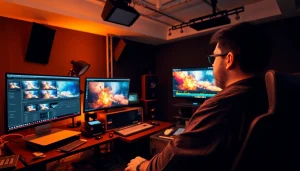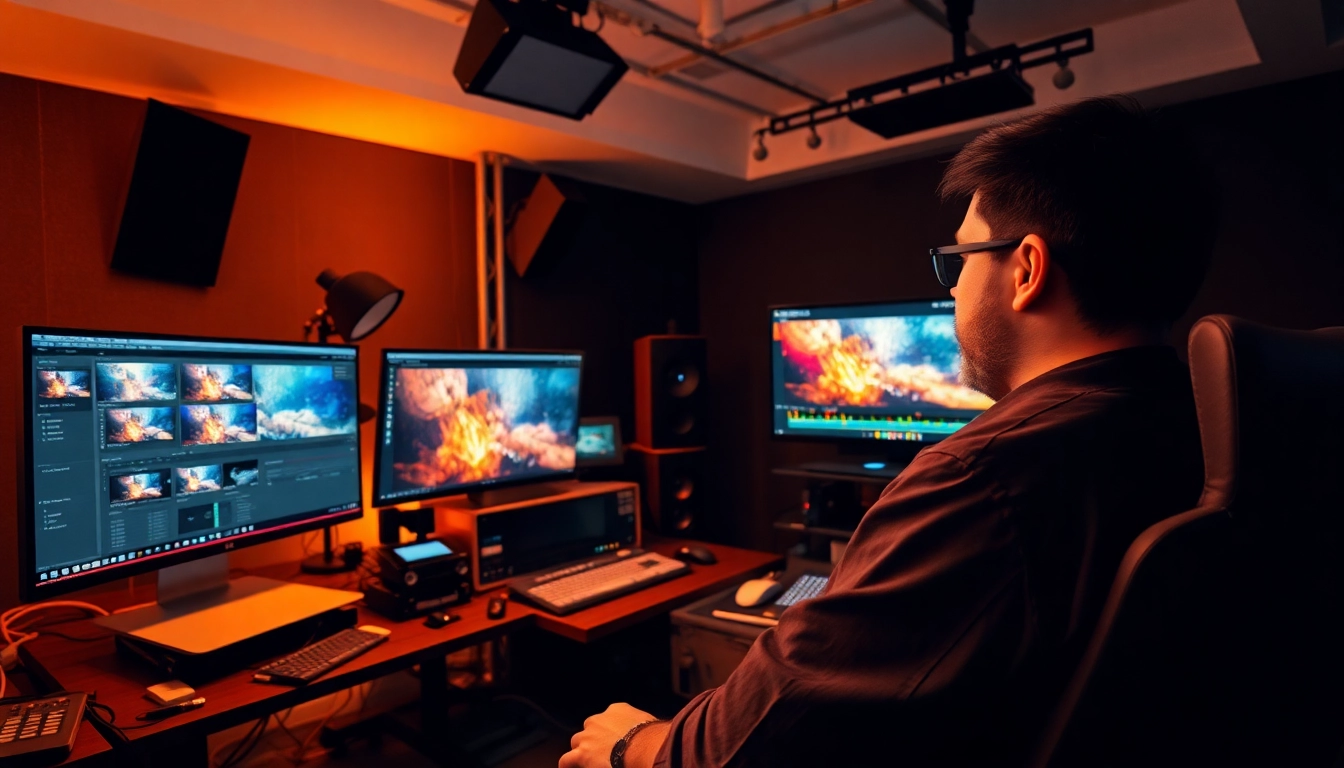Understanding the Basics of Editing & Post-Production
Defining Editing & Post-Production Processes
Editing & Post-Production represents a critical phase in video creation and filmmaking, where raw footage is transformed into a polished final product. This process encompasses a variety of tasks, from cutting and arranging footage to sound design, visual effects, and color correction. Essentially, while pre-production focuses on planning the project and production handles filming, editing & post-production consolidates all the fragments into a coherent narrative. To fully grasp the significance of this stage, it’s vital to differentiate between editing and post-production, as both are indispensable but serve unique functions.
Stages of Video Production
The video production process generally unfolds in three primary stages: pre-production, production, and post-production. Each stage entails specific tasks that build upon one another. In pre-production, concepts are developed, scripts are written, and logistics are organized. During production, directors and crews capture the footage according to the ideas conceptualized earlier.
Upon completion of filming, post-production kicks in. This includes initial editing, visual and sound enhancements, and final touches—contributing to the coherence and narrative strength of the film. All these elements harmonize to influence the pace, emotion, and impact of the final product.
Key Tools in Editing & Post-Production
As technology evolves, the tools for editing & post-production have significantly diversified, enabling creators to achieve unparalleled results. Some key tools include:
- Editing Software: Programs such as Adobe Premiere Pro, Final Cut Pro, and DaVinci Resolve are essential for cutting and arranging video footage.
- Visual Effects Software: Applications like After Effects and Nuke allow the integration of sophisticated visual effects that can elevate storytelling.
- Audio Editing Tools: Software such as Audacity and Pro Tools is crucial for sound design, dialogue editing, and audio mixing.
- Color Grading Software: Programs like Color Finale and DaVinci Resolve ensure color correction and grading to enhance visual storytelling.
Essential Techniques for Effective Editing
Cutting and Arranging Footage
One of the fundamental techniques in editing is cutting footage. This involves selecting the most compelling clips from the raw material and arranging them into a seamless narrative flow. Whether employing a linear or non-linear editing style, it’s crucial to maintain a rhythm that reflects the intended pace of the story. Effective cuts should enhance continuity and clarify transitions, ensuring viewers remain engaged and immersed in the content.
Sound Design and Audio Synchronization
Sound design plays a pivotal role in post-production. Proper audio synchronization ensures that dialogue aligns precisely with on-screen action. Additionally, sound effects and ambient sounds contribute to the overall atmosphere of the film. Techniques to achieve effective sound design include utilizing audio layers, balancing sound levels, and incorporating non-diegetic music to enhance emotional impact.
Color Grading Fundamentals
Color grading is another essential technique within the editing & post-production realm. This process enhances the visual aesthetics of a project by adjusting colors, contrasts, and brightness. Through color grading, editors can create mood, evoke emotions, and establish a visual style that resonates with the audience. Understanding the color wheel and how colors interact plays a crucial role in achieving the desired effect.
Advanced Post-Production Techniques
Visual Effects in Editing & Post-Production
Visual effects (VFX) are increasingly becoming an integral part of modern editing & post-production. These effects not only embellish scenes but can also transform narratives entirely. This can range from adding digital elements to integrating computer-generated imagery (CGI). Familiarity with VFX software and understanding how to mesh these effects with practical footage can significantly enhance storytelling capabilities.
Animating Graphics and Titles
In many projects, animated graphics and titles introduce key scenes, enhance storytelling, and maintain viewer attention. Animation techniques can vary from simple lower-thirds to intricate title sequences that establish the film’s tone. Understanding motion graphics software like Adobe After Effects can empower creators to produce visually compelling titles that fit seamlessly into the narrative flow.
Creating a Cohesive Visual Story
A core objective in editing is to weave a cohesive storyline. This entails considering the overall arc and ensuring that each scene contributes meaningfully to the narrative. Techniques such as establishing shot placement, continuity editing, and thematic consistency are pivotal in shaping how the story unfolds and how characters evolve throughout the film.
Common Challenges in Editing & Post-Production
Managing Workflow and Time Constraints
One of the most pressing challenges in editing & post-production is managing workflow effectively, especially when working under tight deadlines. To tackle this, editors can implement organized file management protocols, checklists for editing processes, and set realistic milestones. Utilizing project management tools can also streamline collaboration and enhance productivity, ensuring timelines are met without compromising quality.
Common Mistakes to Avoid
Every editor is prone to mistakes, but recognizing common pitfalls can prevent significant issues. Some frequent missteps include neglecting audio synchronization, overlooking continuity errors, and failing to back up projects regularly. Awareness of these pitfalls enables editors to take proactive measures, ensuring the production remains on track.
Collaborating with Other Creatives
Collaboration in the editing & post-production phase requires clear communication and established workflows among various team members, including directors, sound designers, and visual effects artists. Effective collaboration can be facilitated through regular check-ins, constructive feedback sessions, and platforms that allow for easy sharing of footage and edits. Establishing a collaborative environment helps to integrate everyone’s insights, further enriching the project.
Measuring Success in Editing & Post-Production
Feedback and Revisions
Receiving feedback is crucial in evaluating the success of editing & post-production. Constructive criticism from peers, directors, and test audiences helps identify strengths and areas for improvement. Editors should remain open to revision, as multiple iterations often lead to refinement and enhanced storytelling.
Evaluating the Impact of Edits
An editor’s ability to assess how edits impact the viewer’s experience is essential. This can be evaluated through audience feedback, viewing metrics, and engagement data. Understanding what resonates with viewers can guide future editing decisions and help refine techniques.
Keeping Up with Industry Trends
The field of editing & post-production is evolving rapidly, with new techniques and tools emerging regularly. Staying updated with industry trends helps editors remain competitive and innovative. Engaging with online communities, attending workshops, and reviewing recent work can spark inspiration and introduce new perspectives that enhance one’s editing approach.
For those looking to explore more about the intricacies and nuances of Editing & Post-Production, a continuous learning mindset is essential. Each element—from the basics to advanced techniques—contributes to the art of visual storytelling.

















